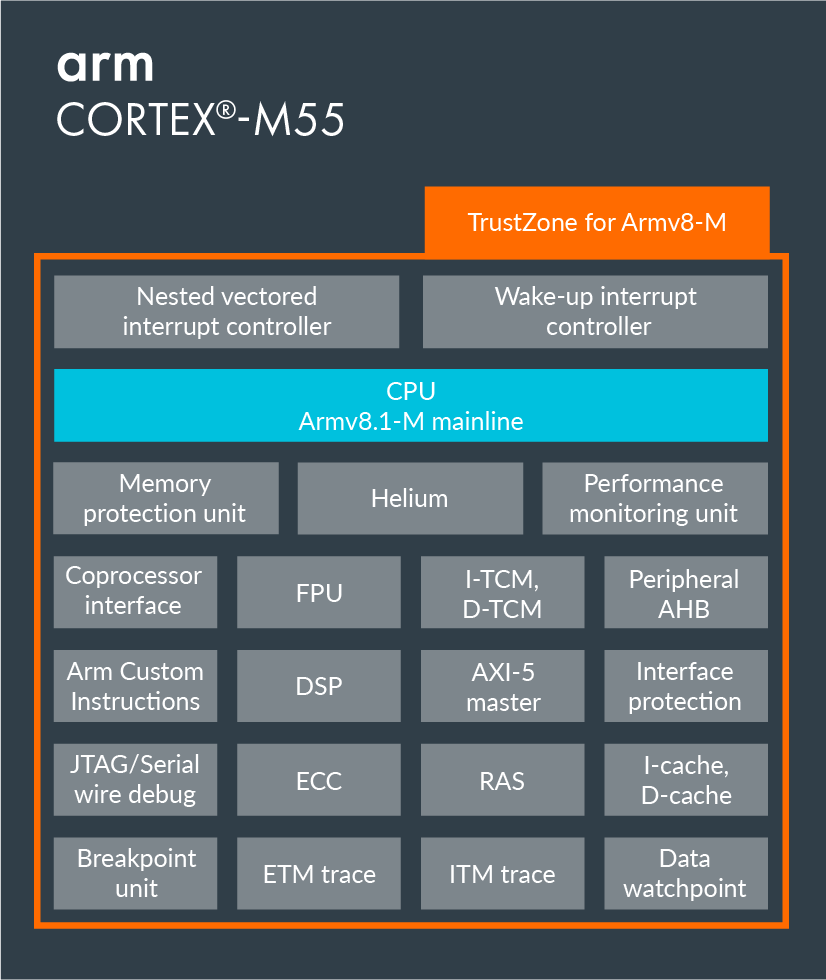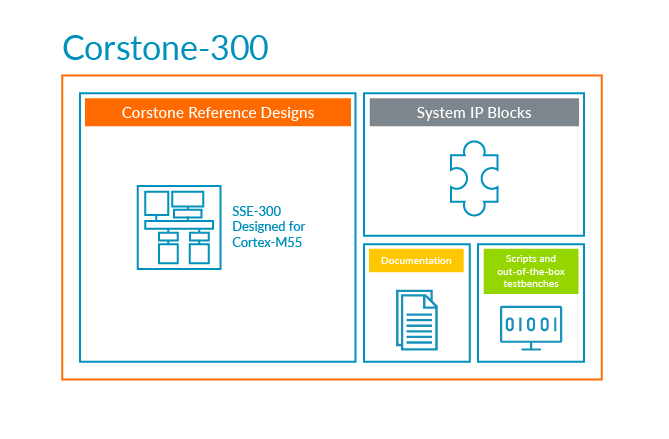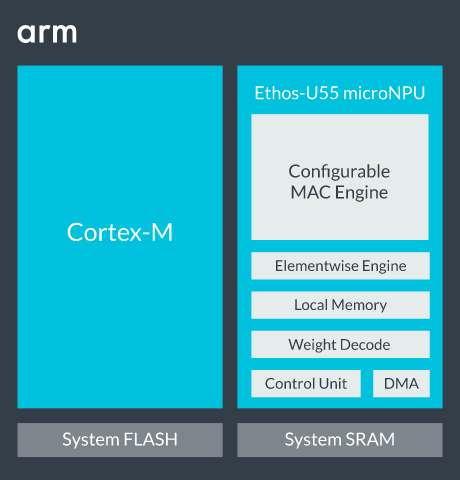Artificial Intelligence and the Internet of Things often go hand in hand with AIoT being a new buzz word that came up last year or so. But for AIoT to scale we need ultra-low-cost, low-power solutions capable of doing inference at the sensor node level, and this is only possible with microcontrollers.
To achieve this goal, Arm has just unveiled the Arm Cortex-M55 microcontroller core optimized for artificial intelligence workloads that delivers up to a 15x uplift in ML performance and a 5x uplift in DSP performance with greater efficiency, as well as Ethos-U55 microNPU designed for Cortex-M microcontrollers that need even more AI performance (up to 480 times faster), while consuming as little power as possible.
Arm Cortex-M55

Key features and specifications:
- Architecture – Armv8.1-M
- Bus interface – AMBA 5 AXI5 64-bit master (compatible to AXI4 IPs)
- Pipeline – 4-stage (for main integer pipeline)
- Security – Arm TrustZone technology (optional)
- DSP extension – 32-bit DSP/SIMD extension
- M-Profile Vector Extension (MVE) – Helium (optional)
- Optional Floating-point Unit (FPU)
- Coprocessor interface – 64-bit (optional)
- Instruction cache – Up to 64KB with ECC (optional)
- Data cache – Up to 64KB with ECC (optional)
- Instruction TCM (ITCM) – Up to 16MB with ECC (optional)
- Data TCM (DTCM) – Up to 16MB with ECC (optional)
- Interrupts – Up to 480 interrupts + Non-maskable interrupt (NMI)
- Wake-up Interrupt Controller (WIC) – Internal and/or external (optional)
- Multiply-accumulate (MAC) / cycle – Up to: 2 x 32-bit MACs/cycle, 4 x 16-bit MACs/cycle, 8 x 8-bit MACs/cycle
- Sleep modes – Multiple power domains, Sleep modes (sleep and deep sleep), Sleep-on-exit, Optional retention support for memories and logic
- Debug – Hardware and software breakpoints, Performance Monitoring Unit (PMU)
- Trace – Optional Instruction trace with Embedded Trace Macrocell (ETM), Data Trace (DWT) (selective data-trace), and Instrumentation Trace (ITM) (software trace)
- Arm Custom Instructions – Optional (available in 2021)
- Robustness – ECC on instruction cache, data cache, instruction TCM, data TCM (optional); Bus interface protection (optional); PMC-100 (Programmable MBIST Controller, optional); Reliability, availability, and serviceability (RAS) extension
The faster ML performance is due to Helium technology and corresponding M-Profile Vector Extension (MVE) that were announced by Arm and covered on CNX Software in February 2019. Arm Cortex-M55 is just the first core to leverage the technology.
Arm Ethos-U55 microNPU
Arm Cortex-M55 cores and future compatible Cortex-M cores can be further extended with Ethos U55 microNPU with the following key features:
- Performance (At 1 GHz) – 64 to 512 GOP/s
- MACs (8×8) – 32, 64, 128, 256
- Utilization on popular networks – Up to 85%
- Data Types – Int-8 and Int-16
- Network Support – CNN and RNN/LSTM
- Winograd Support – No
- Sparsity – Yes
- Memory System
- Internal SRAM – 18 to 50 KB
- External on Chip SRAM – KB to Multi-MB
- Compression – Weights only
- Memory Optimizations – Extended compression, layer/operator fusion
- Debug and Profile – Layer-by-layer visibility with PMUs
- Evaluation and Early Prototyping – Performance Model, Cycle Accurate Model, or FPGA evaluations
Arm Ethos-U55 microNPU is compatible with TensorFlow Lite Micro framework and works on bare-metal Cortex-M55 platforms or ones running an RTOS. Arm provides several software components for the new IP including a TensorFlow Lite Micro runtime, CMSIS-NN, Optimizer, and a driver.
IoT platform Corstone-300

You’ll find more information in the announcement, and respective product pages for Arm Cortex-M55 and Arm Ethos-U55 here and there.

Jean-Luc started CNX Software in 2010 as a part-time endeavor, before quitting his job as a software engineering manager, and starting to write daily news, and reviews full time later in 2011.
Support CNX Software! Donate via cryptocurrencies, become a Patron on Patreon, or purchase goods on Amazon or Aliexpress






For me, the most interesting thing I’ve read is that (you also mentioning this, but this is the full text from the blog):
“Another developer concern is ensuring favorite frameworks and toolchains are fully supported by hardware providers. This is at the heart of our CMSIS work, and our collaboration with fellow AI for IoT innovators like Google to ensure TensorFlow Lite Micro will be fully supported by the Cortex-M55 and Ethos-U55 toolchain.”
This will be nice to see, because my previous benchmarks with TF-Lite micro were a disappointment and CUBE-AI from ST was more than 10x times faster.